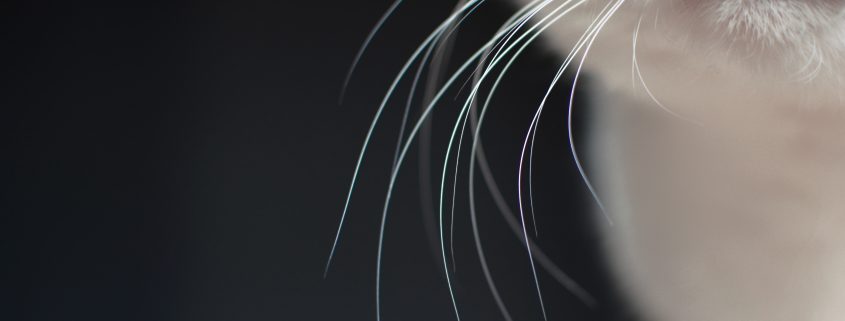Like most species, cats use their eyes, ears, and nose to assess the world around them. However, cats also have an important sensory tool that heightens their perception—their whiskers!
At first glance, you might chalk a cat’s whiskers up to wiry hairs that just make them look even cuter. While whiskers are made of keratin, the same protein as fur, they are much thicker and have deeper roots in the skin, along with many more nerves. In short, while cat whiskers may look adorable, they also serve important purposes, which we’ll cover in this blog.
How they Work
While there are other types of animals with similar appendages, only mammals have ‘vibrissae,’ the scientific term for whiskers. Whiskers are made primarily from the protein alpha-keratin, as is the rest of mammalian hair, but they are not exactly the same. They are noticeably longer than the rest of a cat’s fur and are not found in the dermis of the animal. Rather, they are embedded in the hypodermis, a deeper area of the skin.
The number of vibrissae a cat has will depend on individual factors, with the animal’s breed being an important one. In general, most cats will have between 16 and 24 individual whiskers which emanate from their snout. Although the snout is the most common area, cats also have vibrissae on different parts of the body. They may also have vibrissae on their eyebrows, chin, or on the back of their front paws.
Although whiskers are sometimes called tactile hairs, the whiskers themselves don’t have any sense of touch. Rather, the movement of the whiskers triggers the nerves in the hair follicle, and that information is sent to the brain. This can tell a cat about the location, size, movement, and texture of an object as well as more general environmental information. On the end of each whisker is a tiny organ called a proprioceptor, which detects vibrations in the environment. Proprioceptors enable a cat to sense the position of its own body.
What Are Whiskers For?
Cats use whiskers for a lot of different things. Scientists have discovered that whiskers are involved in food acquisition, facial expression, intraspecies communication, and more. Here is an in-depth look into some of the ways cats use their whiskers.
- Sight – Cats are somewhat farsighted. Whiskers compensate for the trouble cats have focusing on objects close-up. This can be particularly important for hunting. Once a cat pounces on their prey and has it in their paws, their whiskers help them “see” where to deliver the fatal bite.
- Touch – The main function of cat whiskers is the sense of touch. The follicles that these hairs grow from are surrounded by sensory cells. These cells transmit tactile information that’s similar to the signals our fingertips send to our brains. The sensory cells are stimulated by the smallest vibrations in the hair, allowing cats to feel solid objects they brush against and also to notice air currents from movement nearby.
- Spatial Awareness – A cat’s whiskers tell them if they can fit into a space or not. Their muzzle whiskers are as long as they are wide, so whether the whiskers bend when a cat puts its head into a space tells it if the rest of its body will fit. Whiskers don’t just protect cats from getting stuck in tight places, though.
- Righting Reflex – Some whisker follicle cells also have proprioceptive ability, meaning that the way gravity pulls on the hair will tell a cat how they are oriented in relation to the ground. That’s very important for an animal who is always supposed to land on their feet!
- Communication – Finally, cat whiskers can also be involved in communicating with other cats and even observant owners. Tiny muscles around the base of the whiskers allow stressed cats to point their whiskers toward potential threats and relax them when they are content.
Fun Facts about Whiskers
- There’s always an even number – Usually, cats will have 24 whiskers spread out symmetrically, so 12 on each side of their face. Some cats have more than the average 24 whiskers, but if you pay close attention, you’ll notice that there’s always an even number. Having a symmetrical set of whiskers helps your cat accurately assess their surroundings.
- Whiskers shed and grow back – Despite being thicker and stiffer than normal hair, whiskers grow, shed, and grow back just like the rest of your cat’s fur. It’s a normal part of the lifecycle of your cat’s whiskers, and that is why they don’t need trimming or cutting.
- Whiskers can change color – Don’t be surprised if you find a white whisker growing in your pure black cat’s fur as they age. Cats do start going gray with age, but it’s not noticeable unless your cat’s fur is a dark, solid color.
Your Pets are our Priority!
At the National Animal Supplement Council (NASC), our number one priority is to promote the health and well-being of your pets. That is why we created the NASC Audit Program and the Quality Seal, which helps you identify animal health and nutritional supplements that come from responsible suppliers committed to producing the highest quality, most consistent products available. Visit our website to learn more and to see a list of NASC members that have earned the Quality Seal.


